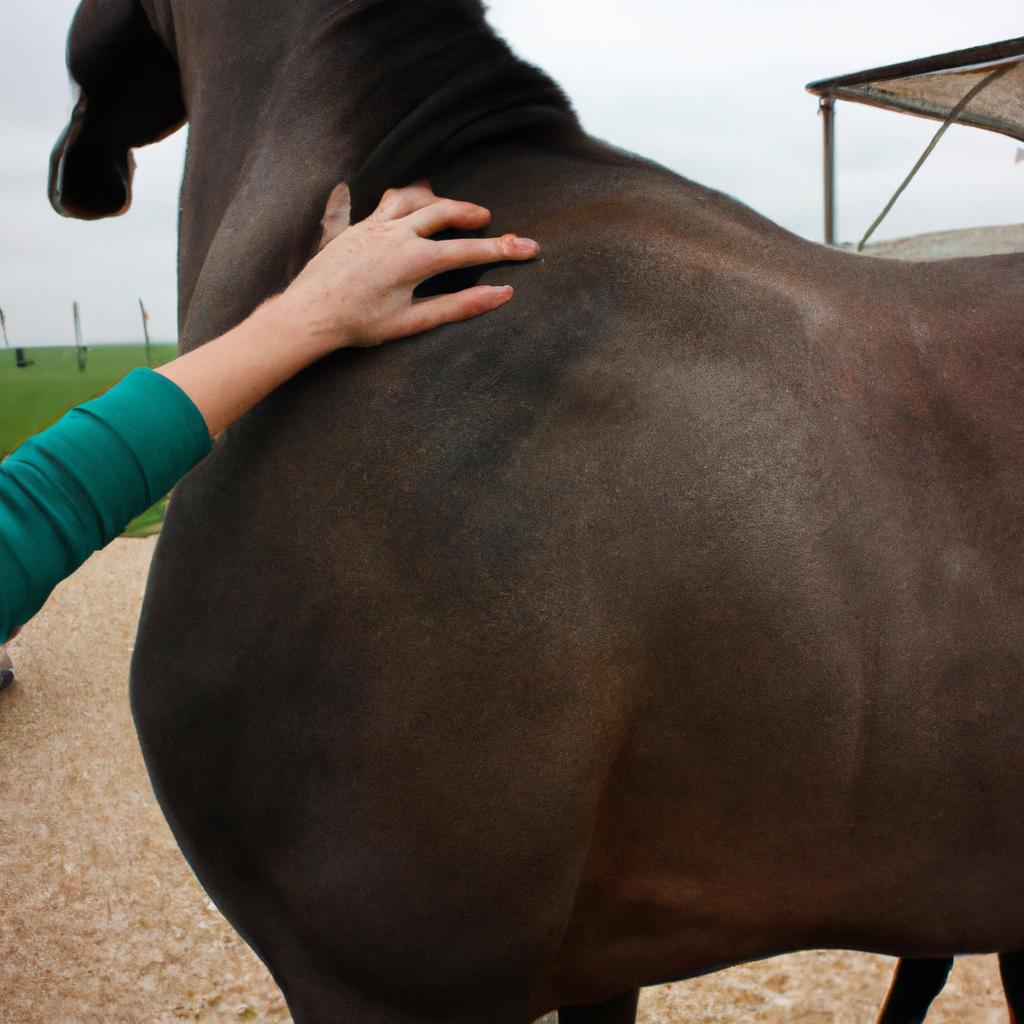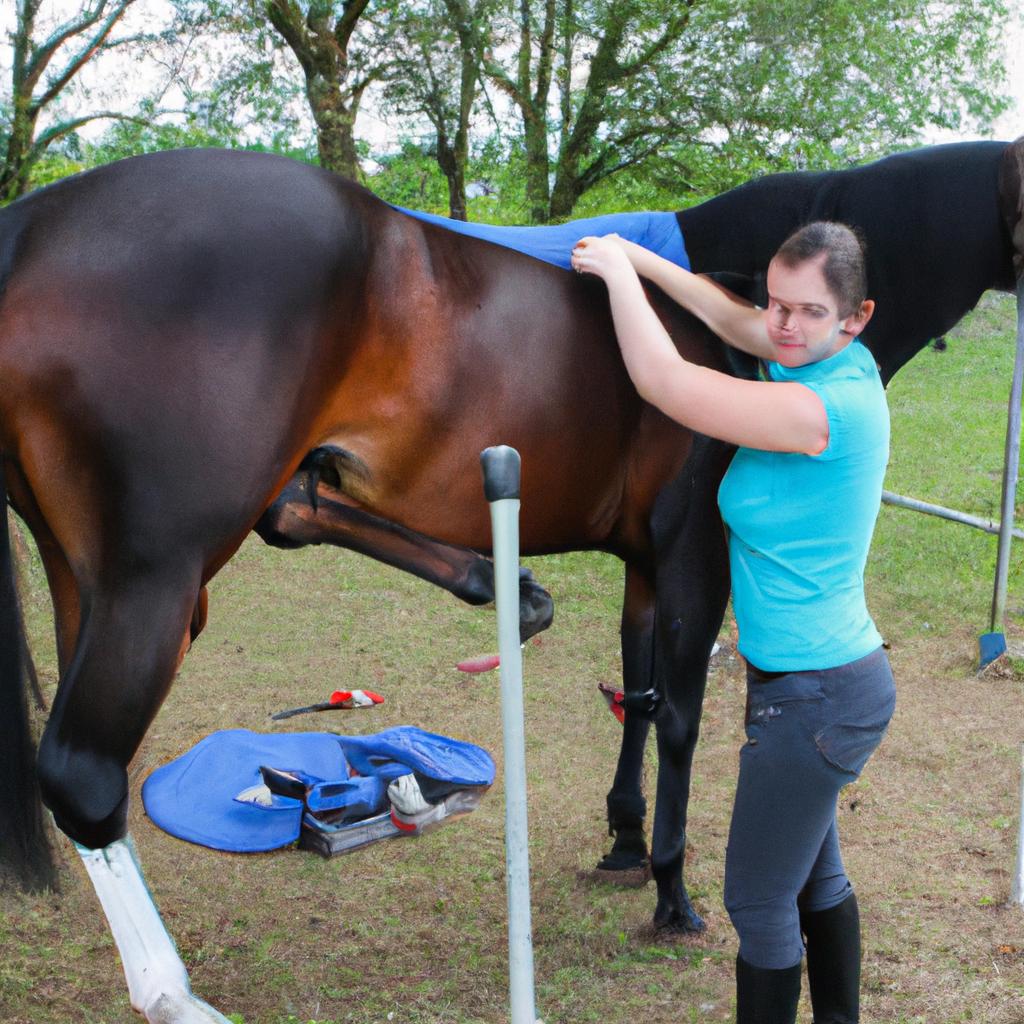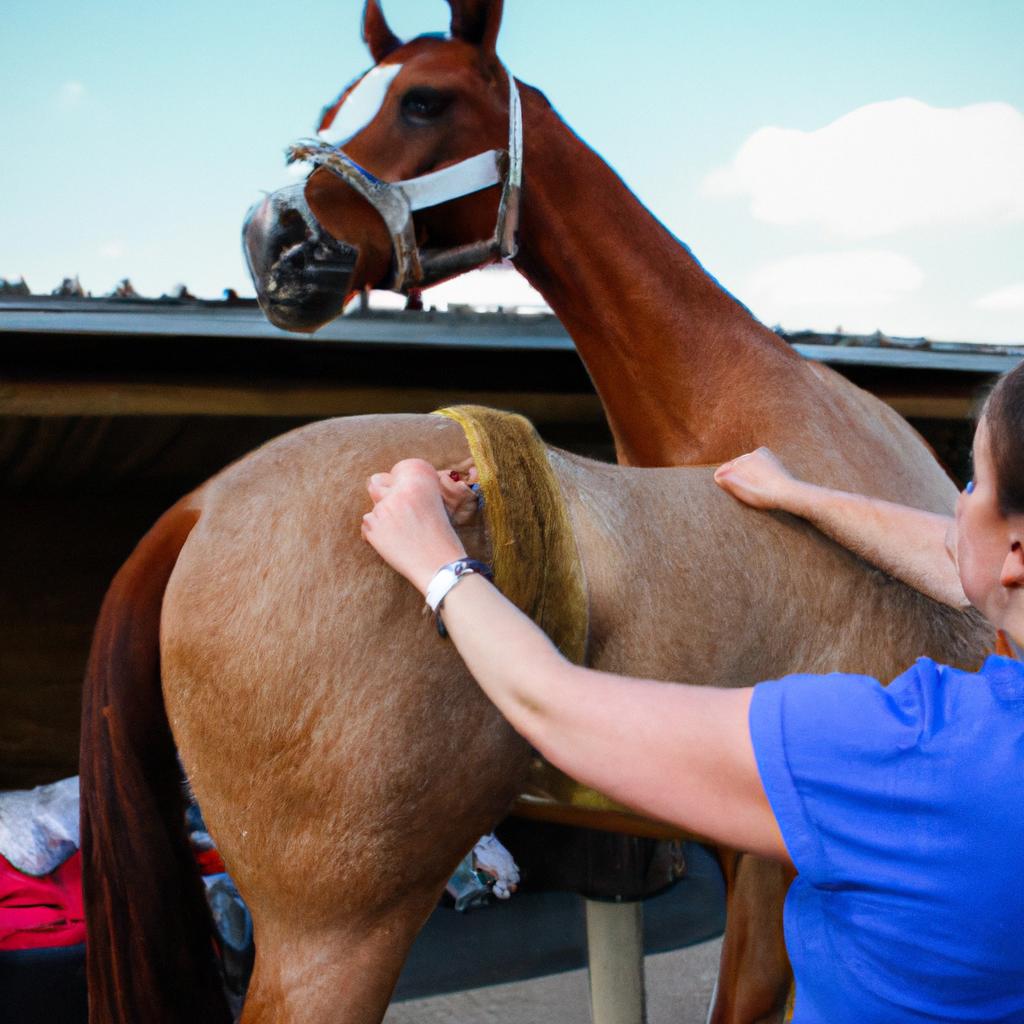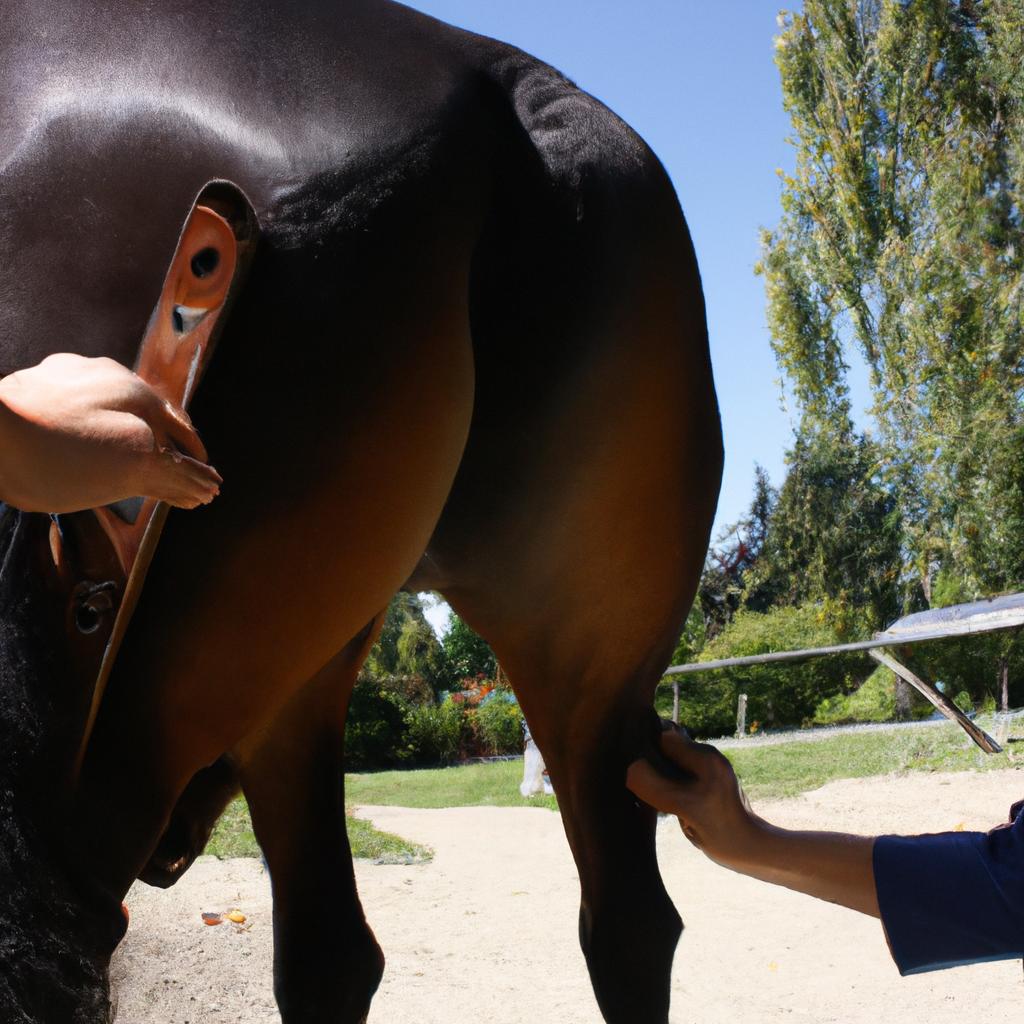The field of equine chiropractic has gained significant attention in recent years, with horse owners increasingly seeking alternative therapies for their beloved animals. Among these therapies, chiropractic care has emerged as a popular option to address musculoskeletal issues and promote overall well-being in horses. However, finding a qualified equine chiropractor can be challenging, particularly when it comes to effective communication with veterinarians who may hold varying opinions on the efficacy of this modality. To illustrate the importance of this topic, consider the hypothetical case of a competitive show jumper suffering from recurrent back pain. The owner is seeking both veterinary advice and potential collaboration with an equine chiropractor to optimize the horse’s performance and prevent further injury.
Effective communication between horse owners or trainers and veterinarians plays an integral role in ensuring optimal healthcare outcomes for horses receiving chiropractic treatments. With differing backgrounds and areas of expertise, veterinarians are often viewed as gatekeepers when it comes to accessing equine chiropractors’ services. Their knowledge and guidance are crucial in determining whether such therapy is suitable for a specific horse’s condition or if additional diagnostic procedures are necessary before initiating treatment. Moreover, veterinarians possess valuable insights into the underlying medical conditions that may contribute to musculoskeletal disorders in horses. By establishing open and honest communication channels, horse owners can benefit from the expertise of both veterinarians and equine chiropractors, leading to a more comprehensive approach to their horse’s care.
Open communication between all parties involved allows for the exchange of information regarding the horse’s medical history, previous treatments, and current symptoms. This collaborative approach helps veterinarians better understand the owner’s goals for seeking chiropractic care and enables them to provide informed advice or recommendations. Equally, it allows equine chiropractors to gain insight into any pre-existing conditions or injuries that may impact their treatment plan.
Through effective communication, veterinarians and equine chiropractors can work together to develop a coordinated treatment strategy. Veterinarians can offer guidance on when chiropractic care is appropriate as a standalone therapy or as part of a broader treatment plan involving medications, physical therapy, or other interventions. They may also provide input on potential contraindications or precautions for specific horses based on their individual health status.
Furthermore, clear lines of communication foster trust and understanding between all parties involved. Open dialogue allows horse owners to express their concerns, ask questions, and discuss any reservations they may have about equine chiropractic care. Conversely, it provides an opportunity for veterinarians and equine chiropractors to educate horse owners about the benefits and limitations of this modality while addressing any misconceptions or uncertainties.
In conclusion, effective communication between horse owners/trainers, veterinarians, and equine chiropractors is paramount in ensuring the optimal well-being of horses receiving chiropractic care. By establishing open lines of communication and fostering collaboration among all parties involved, veterinary professionals and alternative therapy providers can work together towards achieving the best possible outcomes for horses’ musculoskeletal health.
Understanding the role of chiropractic care in equine health
Imagine a scenario where a competitive show jumper named Bella starts experiencing difficulty while performing her usual jumps. Despite being well-trained and physically fit, Bella consistently knocks down bars or refuses to jump altogether. Her owner, concerned about Bella’s performance decline, seeks veterinary advice to find potential underlying causes for this issue.
Chiropractic care as an alternative treatment:
One possible avenue that could be explored is equine chiropractic care. Equine chiropractors are trained professionals who specialize in diagnosing and treating musculoskeletal disorders in horses through manual manipulation techniques. This holistic approach aims to optimize spinal alignment and enhance nervous system function, ultimately improving overall performance and well-being in horses like Bella.
Benefits of equine chiropractic care:
The benefits associated with equine chiropractic care can extend beyond addressing specific issues such as poor jumping performance. Here are several key advantages worth considering:
- Improved range of motion: Chiropractic adjustments can help restore proper joint mobility and alleviate stiffness, allowing horses to move more freely.
- Enhanced athletic performance: By optimizing skeletal alignment and muscular balance, chiropractic care may contribute to improved agility, coordination, and endurance – qualities crucial for equestrian athletes like Bella.
- Pain management: Chiropractic treatments can assist in relieving pain caused by various conditions like muscle spasms or joint inflammation.
- Overall wellness support: Regular maintenance sessions with an equine chiropractor may promote general well-being by helping prevent future injuries or identifying minor issues before they escalate.
Table showcasing the benefits of equine chiropractic care:
| Benefit | Description |
|---|---|
| Improved range of motion | Restores proper joint mobility; alleviates stiffness |
| Enhanced athletic performance | Optimizes skeletal alignment; improves agility, coordination, and endurance |
| Pain management | Assists in relieving pain from muscle spasms or joint inflammation |
| Overall wellness support | Promotes general well-being; prevents future injuries and identifies minor issues before they escalate |
The importance of effective communication with veterinarians:
Understanding the role that chiropractic care can play in equine health is crucial, particularly when it comes to collaborating effectively with veterinarians. By establishing open lines of communication, both professionals can work together to ensure comprehensive care for horses like Bella. In the following section, we will explore how such collaboration can be achieved and why it is essential for optimal equine healthcare.
The importance of effective communication with veterinarians
Understanding the Role of Chiropractic Care in Equine Health
Equine chiropractic care plays a significant role in promoting the overall well-being and performance of horses. By addressing musculoskeletal issues, it can help alleviate pain, improve mobility, enhance athletic ability, and support the horse’s general health. To better comprehend the value of chiropractic care for horses, let us explore a hypothetical scenario.
Imagine an eventing horse named Bella who is experiencing difficulty during her jumping sessions. Despite receiving regular veterinary check-ups, there seems to be no apparent cause for her discomfort. In this case, seeking out the services of a qualified equine chiropractor may provide insights into potential underlying issues that could be affecting Bella’s performance.
Effective communication between veterinarians and equine chiropractors is crucial when considering holistic treatment options for horses. This collaboration ensures comprehensive healthcare management that addresses both medical conditions requiring traditional veterinary intervention and musculoskeletal problems amenable to chiropractic care. To facilitate productive dialogue among professionals involved in equine healthcare, consider the following:
- Open-mindedness: Both parties should approach discussions with receptiveness towards alternative therapies while respecting each other’s expertise.
- Mutual respect: Recognize and appreciate each practitioner’s contributions to the horse’s well-being, acknowledging their individual strengths within their respective fields.
- Information sharing: Regularly exchange relevant clinical findings, diagnostic results, and treatment plans to foster cooperative decision-making.
- Continued education: Stay updated on advancements in veterinary medicine as well as complementary modalities like equine chiropractic care through professional development opportunities.
To further illustrate these points visually:
Table 1: Factors Promoting Effective Communication Between Veterinarians and Equine Chiropractors
| Factors | Description |
|---|---|
| Open-Mindedness | Willingness to consider different approaches and therapies outside one’s primary field. |
| Mutual Respect | Acknowledgment and appreciation of each practitioner’s expertise. |
| Information Sharing | Regular exchange of relevant clinical findings, diagnostic results, and treatment plans. |
| Continued Education | Staying updated on advancements in veterinary medicine and complementary modalities through professional development opportunities. |
In summary, effective communication between veterinarians and equine chiropractors is essential to provide comprehensive care for horses. By fostering collaboration based on open-mindedness, mutual respect, information sharing, and continued education, professionals can optimize the well-being of their equine patients.
Transitioning into the subsequent section about “Identifying the signs that may indicate the need for chiropractic intervention,” it is important to recognize specific indicators that suggest a horse could benefit from chiropractic assessment and treatment.
Identifying the signs that may indicate the need for chiropractic intervention
Effective communication between equine chiropractors and veterinarians is crucial for providing comprehensive care to horses. By establishing a collaborative relationship, both professionals can work together to ensure the well-being and optimal health of these magnificent animals. To illustrate this point, let’s consider a hypothetical scenario where a horse owner notices signs of discomfort in their beloved steed but is unsure whether it requires chiropractic intervention or veterinary attention.
Imagine a situation where a horse named Bella starts showing signs of stiffness during exercise. The owner, concerned about her well-being, seeks advice from both an equine chiropractor and a veterinarian. In this case, effective communication between these two professionals becomes essential as they evaluate Bella’s condition collaboratively.
To facilitate successful communication with veterinarians regarding chiropractic interventions for horses, consider the following:
-
Mutual Respect and Understanding:
- Equine chiropractors should respect the expertise and knowledge that veterinarians bring to the table.
- Veterinarians need to acknowledge the benefits of chiropractic care when appropriate.
-
Open Dialogue:
- Both parties should engage in open discussions about the horse’s medical history, current symptoms, and treatment plans.
- Sharing information helps create synergy between the different modalities of healthcare.
-
Clear Goals:
- Establishing shared goals ensures that all involved practitioners are working towards improving the horse’s overall well-being.
- Setting clear objectives facilitates effective collaboration throughout the treatment process.
-
Regular Updates:
- Maintaining regular communication through progress reports enables each professional to stay informed about any changes or developments concerning the horse’s condition.
In summary, effective communication between veterinarians and equine chiropractors plays a vital role in delivering holistic care for horses like Bella. By fostering mutual respect, engaging in open dialogue, setting clear goals, and maintaining regular updates, these professionals can provide comprehensive and well-coordinated care. In the following section, we will explore how collaboration between veterinarians and equine chiropractors can result in a holistic approach that maximizes the health benefits for our equine companions.
Collaboration between veterinarians and equine chiropractors: A holistic approach
Identifying the signs that may indicate the need for chiropractic intervention in horses is crucial for ensuring their optimal health and well-being. By recognizing these indicators early on, horse owners can seek appropriate care from qualified equine chiropractors to address potential issues promptly. One such example is a case where a horse experiences difficulty bending or flexing its neck during training sessions. This could be indicative of subluxations or misalignments within the spine, which can benefit from chiropractic adjustments.
When considering whether chiropractic intervention is necessary for a horse, several key factors should be taken into account:
- Performance Issues: If a horse consistently demonstrates decreased performance levels or exhibits resistance while performing certain movements, it may signal underlying musculoskeletal problems that require attention.
- Behavioral Changes: Sudden changes in behavior, such as increased irritability or unwillingness to engage in activities they previously enjoyed, might also point towards discomfort or pain related to spinal issues.
- Uneven Gait: Observing an uneven gait or irregular movement patterns when the horse walks, trots, or canters could signify imbalances within their skeletal structure.
- Limited Range of Motion: Difficulty with lateral flexibility, stiffness when turning, or reluctance to extend fully during exercise are all indications that warrant further investigation by an equine chiropractor.
To emphasize the significance of recognizing these signs and seeking timely intervention, consider the following bullet-pointed list:
- Early detection and treatment can prevent minor issues from developing into more serious conditions.
- Chiropractic care enables horses to maintain proper biomechanics and perform at their best potential.
- Addressing physical discomfort enhances overall well-being and positively impacts temperament.
- Improved mobility contributes to better joint health and reduces the risk of long-term damage.
In addition to understanding the signs necessitating chiropractic intervention, collaboration between veterinarians and equine chiropractors plays a vital role in providing holistic care for horses. The table below illustrates the complementary nature of their expertise:
| Veterinarians | Equine Chiropractors |
|---|---|
| Diagnose and treat medical conditions | Assess spinal misalignments |
| Prescribe medication or surgery when necessary | Perform manual adjustments to correct subluxations |
| Conduct diagnostic imaging (e.g., X-rays, ultrasounds) | Utilize palpation techniques to identify problem areas |
| Provide vaccinations and routine health check-ups | Offer ongoing maintenance care for musculoskeletal health |
By recognizing the unique strengths each profession brings to horse healthcare, a collaborative approach can optimize treatment outcomes and promote overall well-being.
Transitioning into the subsequent section about “Choosing a qualified equine chiropractor: Key considerations,” it is essential to understand how horse owners can make informed decisions in seeking appropriate care for their horses.
Choosing a qualified equine chiropractor: Key considerations
Collaboration between veterinarians and equine chiropractors is essential in providing a holistic approach to horse health. By working together, these professionals can ensure the overall well-being of the animal. Now, let’s explore some key considerations when choosing a qualified equine chiropractor.
To illustrate the importance of collaboration, consider this hypothetical scenario: A racehorse named Thunder experiences stiffness and decreased performance. The owner seeks help from both their trusted veterinarian and an experienced equine chiropractor. Through close cooperation, they are able to identify that Thunder’s discomfort stems from a combination of musculoskeletal issues and underlying medical conditions. With this comprehensive understanding, they develop a treatment plan that includes both veterinary care and chiropractic adjustments tailored specifically for Thunder’s needs.
When selecting an equine chiropractor, it is crucial to keep the following factors in mind:
- Credentials: Look for certifications or memberships with reputable organizations such as the American Veterinary Chiropractic Association (AVCA) or International Veterinary Chiropractic Association (IVCA).
- Experience: Consider practitioners who have ample experience working with horses similar to yours in terms of breed, discipline, and age.
- Communication skills: Choose someone who effectively communicates findings and treatment plans with you as well as your veterinarian.
- Collaboration mindset: Find an equine chiropractor who values teamwork and actively collaborates with other healthcare providers involved in your horse’s care.
Additionally, it may be helpful to understand the different approaches used by veterinarians and equine chiropractors through visual aids like the table provided below:
| Veterinarian | Equine Chiropractor | |
|---|---|---|
| Training | Extensive medical education & surgical training | Specialized training in spinal manipulation techniques |
| Focus | Diagnosis & treatment of diseases/conditions | Identification & correction of vertebral subluxations |
| Tools | X-rays, ultrasound, medication administration | Manual adjustments, muscle work, and physical therapy |
| Treatment | Medication, surgery, rehabilitation protocols | Spinal manipulations to restore musculoskeletal balance |
In conclusion, collaboration between veterinarians and equine chiropractors is crucial for providing a holistic approach to horse health. By choosing a qualified equine chiropractor who possesses the necessary credentials, experience, effective communication skills, and a collaborative mindset, you can ensure your horse receives the best care possible.
Moving forward, let’s delve into some practical tips for effective communication with your equine chiropractor as we continue on our journey towards finding optimal solutions for your horse’s well-being.
Tips for effective communication with your equine chiropractor
Choosing a qualified equine chiropractor is crucial for the overall well-being and health of your horse. Once you have found an experienced and reputable practitioner, effective communication becomes essential in ensuring that both parties are on the same page regarding treatment goals, progress, and any concerns or questions that may arise during the course of care.
For example, consider a hypothetical scenario where a horse named Bella has been experiencing intermittent lameness and stiffness in her hind limbs. Her owner decides to seek chiropractic care as part of her holistic approach to managing Bella’s musculoskeletal issues. In order to find a qualified equine chiropractor who can address Bella’s specific needs, the following key considerations should be taken into account:
-
Qualifications: Ensure that the practitioner has completed appropriate training from an accredited institution specializing in animal chiropractic. Look for certifications such as AVCA (American Veterinary Chiropractic Association) or IVCA (International Veterinary Chiropractic Association).
-
Experience: It is important to inquire about the chiropractor’s experience working with horses similar to yours in terms of breed, discipline, and specific conditions or injuries. A seasoned practitioner will have dealt with various cases and possess valuable knowledge and expertise.
-
Referrals: Seek recommendations from trusted sources such as veterinarians, trainers, fellow horse owners, or local equine organizations. Hearing positive experiences from others who have worked with the chiropractor can provide reassurance when making your decision.
-
Communication style: Pay attention to how effectively the chiropractor communicates and explains their treatment plans and options. Clear communication is vital for establishing trust between all involved parties – yourself, the veterinarian(s), and the chiropractor – which ultimately contributes to better outcomes for your horse.
- Improved understanding leads to tailored treatments.
- Trust and confidence are fostered through transparent dialogue.
- Early detection of potential complications can prevent further issues.
- Collaboration allows for holistic care, combining chiropractic treatment with other modalities.
To illustrate the significance of communication in a concise manner, refer to this three-column table:
| Communication Benefits | Emotional Impact |
|---|---|
| Clear understanding of treatment goals | Relief from uncertainty |
| Regular updates on progress | Peace of mind |
| Addressing concerns promptly | Reduced anxiety |
| Collaborative approach to care | Sense of empowerment |
In conclusion, effective communication between horse owners and equine chiropractors is essential when seeking chiropractic care. By considering qualifications, experience, referrals, and communication style, you can ensure that your chosen practitioner will be capable of addressing your horse’s specific needs. Fostering open and honest dialogue contributes to a trusting relationship that enhances the overall well-being and health outcomes for your beloved equine companion.
 Eq Muscle Release
Eq Muscle Release




